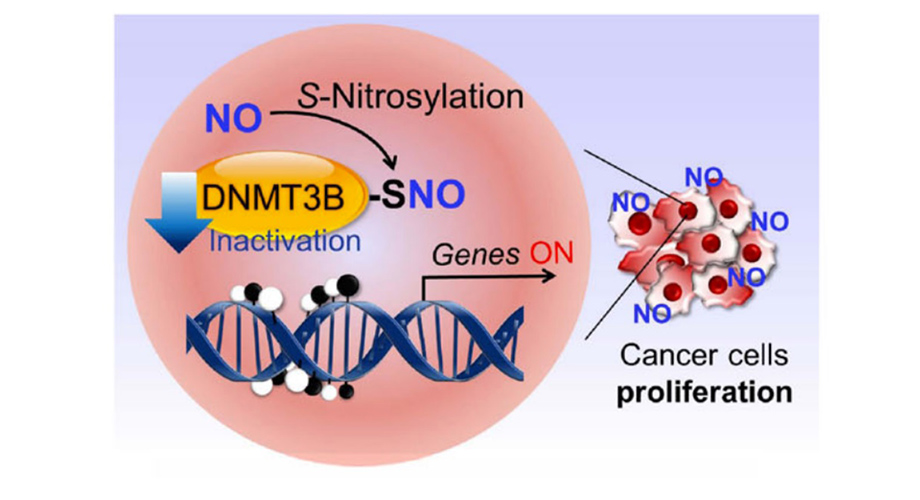
Researchers discovered that when the protein DNMT3B becomes S-nitrosylated in the presence of nitric oxide (NO), cancer-related genes become activated, leading to the proliferation of tumor cells. Credit: Tomo Nakamura and Stuart Lipton, Scripps Research.
Chemically “poisoned” protein acts as a molecular switch to spur cancer formation
The discovery triggered development of a new potential drug to eliminate tumor formation.
February 16, 2023
LA JOLLA, CA—Scientists at Scripps Research, with collaborators in Japan, have discovered how a “poisoned” form of a protein could set off a cascade of events that encourage the growth of some cancers. The research, published in Nature Communications on February 4, also triggered development of a drug candidate that can revert the protein to its normal form. In mice with colon cancer, the drug prevented or dramatically slowed formation of tumors.
“This is a potentially very important and druggable link between the environment, genes and cancer,” says senior author Stuart Lipton, MD, PhD, professor and Step Family Foundation Endowed Chair in the Department of Molecular Medicine at Scripps Research and a clinical neurologist in La Jolla, Calif.
The study was a collaboration with a team led by Takashi Uehara at Okayama University in Japan.
Lipton’s research group previously discovered a process called protein S-nitrosylation, in which a molecule related to nitric oxide (NO) binds to sulfur atoms within proteins to change those proteins’ functions. NO is found naturally within the body and produced in response to inflammation. But it also can form from nitrates and nitrites that are eaten (in the form of processed meats) or breathed in (through cigarette smoke or air pollution). Recently, the team showed how S-nitrosylation might contribute to Alzheimer’s disease as well as Parkinson’s disease, Lewy body dementia, Lou Gehrig’s disease (ALS) and some forms of autism.
Separately, scientists know that many genes can be turned on or off by proteins called DNA methyltransferases (a process known as epigenetic control of gene expression). When these proteins add a methyl group—a kind of chemical marker—to a strand of DNA, they keep nearby genes from being activated. In some cancers, those methyl “silencers” are removed, and genes involved in tumor growth and spread get abnormally turned on.
“If you block methylation, genes get turned on when they shouldn’t be, and that’s been known to be an important driver of some cancers,” says Lipton. “But no one knew the prime trigger for this process.”
In the work, Lipton, with Scripps Research investigator Tomohiro Nakamura and their colleagues in Japan, showed that when DNA methyltrasferase 3B (DNMT3B) is S-nitrosylated—which can happen in the presence of high levels of NO—it no longer adds methyl groups to DNA. This then enables certain those cancer-causing genes to turn on. The findings suggest one way that processed meats, air pollution, cigarette smoke and inflammation—all linked to some forms of cancer—could flip DNMT3B to its cancer-promoting form.
“It’s like a poisoned form of DNMT3B,” says Lipton.
The group went on to show that when DNMT3B is “poisoned” in this way, expression levels of 173 different genes in human cells changed. Among these genes is Ccnd2, which was already known to be involved in the formation of gastric and colon cancers in humans.
The research group in Japan then designed a drug that would prevent DNMT3B from being S-nitrosylated, but not block its normal function or affect the S-nitrosylation of any other proteins. This prevented NO, even when present at high levels, from converting DNMT3B into the “poisoned” form.
Lipton and Uehara’s teams found that the drug, known as DBIC, prevented isolated precancerous colon cells from turning into full-blown colon cancer in the lab. Moreover, when they gave DBIC to mice prone to colon cancer, the drug virtually prevented tumors from forming, even when inflammation produced high levels of NO.
The researchers think that the S-nitrosylation of DNMT3B is likely associated with other cancers, including brain and breast cancer. They’re planning more research on the full list of genes that are impacted by S-nitrosylated DNMT3B.
“We still don’t know the full panoply of tumor types that this molecular switch might be associated with,” says Lipton. “We’ll be pursuing that in the future, as well as trying to move DBIC toward human clinical trials.”
In addition to Lipton and Uehara, authors of the study, “Pivotal role for S-nitrosylation of DNA methyltransferase 3B in epigenetic regulation of tumorigenesis,” were Nhi Lang and Tomohiro Nakamura of Scripps Research; Kosaku Okuda, Kengo Nakahara, Yuta Iijima, Ryosuke Nomura, Kana Fujikawa, Kazuya Adachi, Yuki Shimada, Satoshi Fujio, Reina Yamamoto, Nobumasa Takasugi, Taichi Ukegawa, Yasuo Takeuchi, Norihisa Yasui and Atsuko Yamashita of Okayama University; Akihiro Ito of Tokyo University of Pharmacy and Life Sciences; Ashutosh Kumar and Kam Y. J. Zhang of RIKEN; Kunishige Onuma, Mitsuhiko Osaki and Futoshi Okada of Tottori University; Hiroyuki Marusawa of Kyoto University; Yosuke Matsushita and Toyomasa Katagiri of Tokushima University; Takahiro Shibata of Nagoya University; Koji Uchida of the University of Tokyo; and Sheng-Yong Niu of the Broad Institute of Harvard and MIT.
This work was supported by funding from the Ministry of Education, Culture, Sports and Technology of Japan (15H04649, 18H02579, 25670029, 15K14952, 17H06170), JSPS Research Fellowships (16J00339, 21J12602, 20J21060), JST (JPMJFS2128 ), JST SPRING (JPMJSP2126), the Translational Research Network Program (16lm0103011j0003), the Project for Cancer Research and Therapeutic Evolution (19cm0106436h0002) from the Japan Agency for Medical Research and Development, Joint Usage and Joint Research Programs, the Institute of Advanced Medical Sciences, Tokushima University, the National Institutes of Health (R01 AG061845, RF1 NS123298, R61 NS122098, DP1 DA041722, R01 AG056259, R01 AG078756, RF1 AG057409, R35 AG071734, TRDRP Grant 27IR-0010).
For more information, contact press@scripps.edu

